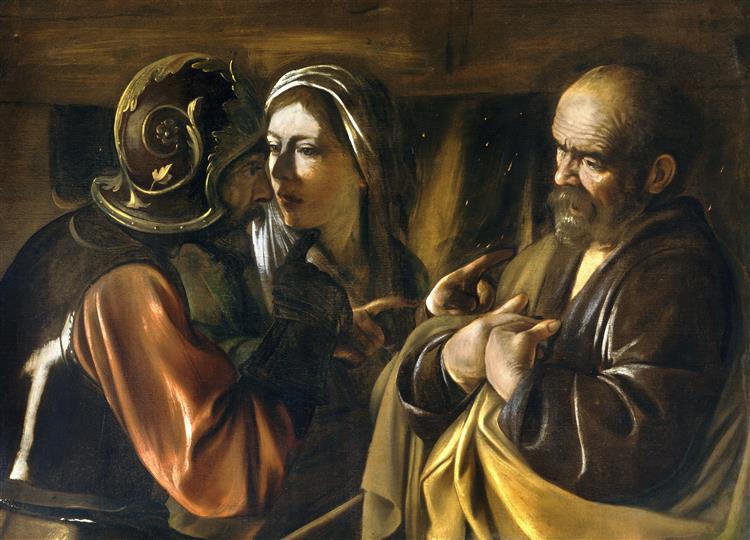Tanım
Caravaggio's painting "The Denial of Saint Peter," created in 1610, stands as a formidable example of the Italian artist's mastery of light, emotion and visual storytelling. In this painting, Caravaggio captures the dramatic moment when Saint Peter, the apostle closest to Jesus, denies knowing his master, an episode found in the gospels that resonates with themes of betrayal, regret and human frailty.
From the first glance, the viewer is immediately drawn to the central composition of the work. St. Peter, a figure of notable prominence, is in a posture of apparent indecision and anguish. His facial features and body language convey a deep emotional turmoil, an internal conflict that reflects the tension of the moment. The lighting, characteristic of Caravaggio's tenebrist style, accentuates Peter's face, casting light and shadow that intensifies the atmosphere of the scene. The use of light—with a beam highlighting the figure of the apostle against a dark background—focuses attention on Peter's humanity, turning a historical event into an introspective portrait of human weakness.
The colours in the work are predominantly dark, with a subtle use of warmer hues on the characters' skin, providing a sense of immediacy and realism. The restrained palette has been a distinctive feature of Caravaggio's use of darker colours that emphasise flesh and life, making the viewer feel the tangible reality of the scene. This approach, in addition to his chiaroscuro technique, not only marks his style, but also increases the dramatic tension of the visual narrative.
The figure of the woman in the work is equally remarkable. Her expression and posture suggest contempt and inquisition. By pointing at Peter, she underlines his betrayal by revealing to him the stark fact that she does not recognize him. This confrontation emphasizes not only Peter's betrayal, but also the loneliness and isolation that comes with denial. Through subtle interactions between the characters, Caravaggio manages to create a visual dialogue that invites the viewer to contemplate the psychology of the actors involved.
The historical context in which the work is set also deserves mention. Painted at the end of Caravaggio's life, "Denial of St. Peter" is part of a period in which the artist had already gone through many personal and professional adventures, including criminality and the search for redemption. This background influences his work, charging each brushstroke with raw emotion that is palpable.
Caravaggio, recognized as one of the masters of the Baroque, laid the groundwork for the development of naturalism in painting. His work influenced countless later artists, who admired his technique and innovative approach to visual narrative. The Denial of St. Peter, in particular, not only aligns with his style, but can also be seen as a precursor to the emotional representation that would later characterize Baroque painting.
In conclusion, “The Denial of Saint Peter” is not only a masterpiece by Caravaggio; it is a profound exploration of the human condition that resonates through the centuries. The artist’s ability to capture the immediacy of the moment, his handling of light and shadow, as well as the complicated emotional portraits of his subjects, make this painting a rigorous testament to the depth of Baroque art and its enduring relevance in art history. Situated at the crossroads of history, religion, and human experience, the work continues to inspire and challenge contemporary viewers, reminding us of the fragility of our beliefs and the complexity of our choices.
KUADROS ©, a famous painting on your wall.
Hand-made oil painting reproductions, with the quality of professional artists and the distinctive seal of KUADROS ©.
Painting reproduction service with satisfaction guarantee. If you are not completely satisfied with the replica of your painting, we will refund 100% of your money.

